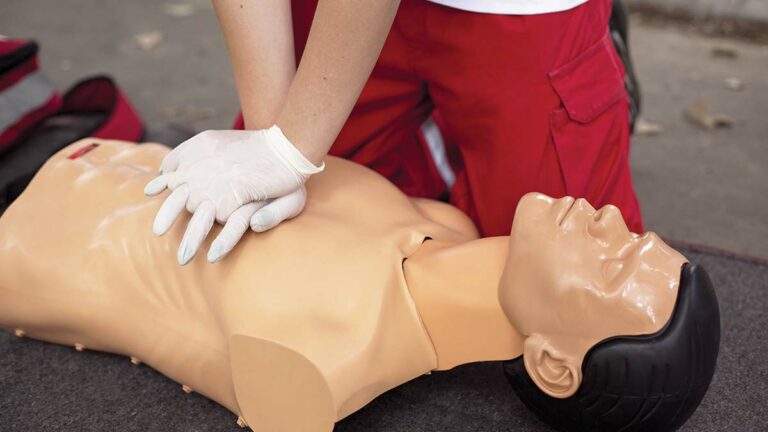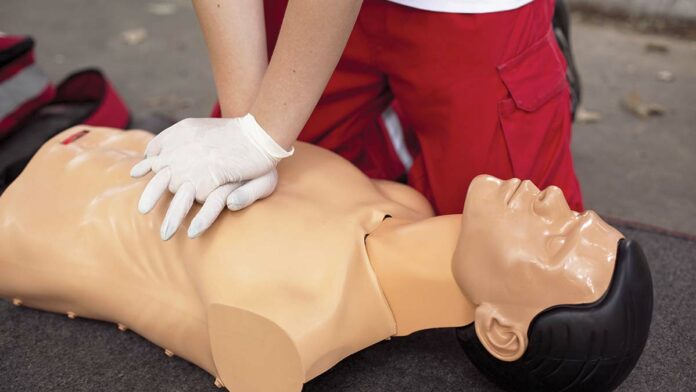Ask Don Scott to tell the story of how two UCSC students rescued him from a heart attack in a crowded theater and he’ll say all he knows is that he blacked out.
The Monterey musician was about to perform with his wife, Charmaigne Scott, for a psychology and religion class of 350 students on Dec. 1 when he collapsed onstage.
“I don’t remember driving up. I don’t remember picking my equipment out of the car, and I don’t remember falling down and being revived,” says Don Scott, 66.
What he does remember: waking up at Dominican Hospital after doctors had chilled his body, inducing something like a coma, and operated on him. He stayed at Domincan for 16 days and was told he likely had had prior heart attacks without realizing it, and his brain showed evidence of multiple strokes. He is now in long-term recovery and speech therapy, but feels nearly normal and is playing music again, he says.
Scott’s wife, Charmaigne, says she heard the entire theater gasp when he collapsed, and she ran over to see his eyes rolling back into his head. She describes the following seven minutes as “amazing,” as she watched with the audience as two “angels” from the crowd used CPR to breathe into his lungs and pump his heart until paramedics arrived.
“I can only think that it was providence that got him to the theater when he did,” Charmaigne Scott says, “because if it had been 15 minutes earlier or it had occurred while he was on the road, he wouldn’t even have had a phone.”
Craig Schindler, the class’ guest lecturer, says the rescue was powerful and beautiful.
“If you’ve ever been to a birth, or if you’ve ever been to a dying process, there’s this sense of the veil thinning. There’s this sense of being in the presence of something that’s bigger than any of us,” Schindler says.
In the Moment
UCSC senior Luke Smith, 23, was sitting in the back row when he saw Don Scott collapse. Smith, a former Southern California lifeguard, had given CPR a few times during beach rescues but said he was not prepared to perform that day. For one thing, he had a broken wrist in a cast. He also didn’t know if the theater was equipped with a defibrillator.
Don Scott is diabetic, so at first his wife and fellow musicians thought he needed some sugar. But no sweets could be found, and he wasn’t responding.
“I just had that moment of clarity,” says Vierra. “This is all there is and I’m in this moment. I’m going to do this and I know how. I didn’t even think.”
Smith says he sat there, stunned and not fully grasping the emergency of the moment.
“I kind of said something like, ‘Oh, does anybody know CPR?’” Smith remembers, before noticing that the entire class was frozen still. “I didn’t realize I should have just jumped up, and it took a minute to realize.”
He snapped to action and ran down the aisle, yelling for classmates to call 911 and get the defibrillator.
Jenni Vierra, a 27-year-old single mother, was also at the back of the room watching the scene. The pre-medicine student had taken a CPR class this past spring at Cabrillo College before transferring to UCSC.
“I noticed his chest doing this jerking, rising, falling thing, and immediately recognized it as an unconscious gasp, not low blood sugar,” says Vierra. “So I jump up and I told the girl sitting next to me, ‘call 911 right now.’”
The gasping, also known as agonal respiration, is often seen in heart attacks and is a clear sign that the victim needs help to breathe.
Vierra ran to help Smith administer CPR. She performed chest compressions and he gave breaths.
“I just had that moment of clarity,” says Vierra. “This is all there is and I’m in this moment. I’m going to do this and I know how. I didn’t even think. It’s just thoughts without words and just being completely present in the moment.”
Someone came with the defibrillator just as the fire department paramedics arrived. Scott’s pulse was restored, a breathing machine was inserted, and he was whisked away.
Four Keys to Rescue
Mark Ramsey, a Cabrillo CPR instructor and assistant athletic training director, says CPR is usually not enough to revive a heart attack victim.
“If you catch them early enough then you can increase the chance of getting the person back, but a lot of the time CPR alone isn’t effective,” says Ramsey. “You’re just trying to keep blood pumping to the brain while you’re waiting for emergency medical services to get there.”
Ramsey says the first step is recognizing the emergency and calling 911 for help. He teaches students to look for signs of life: skin color, movement, breathing, and consciousness. If the victim is unresponsive, pale or blue, or their chest is not moving, then it’s time to call 911 and begin CPR, he says.
Students in his class receive certification from the American Heart Association (AHA), which updates its guidelines on best CPR practices every few years.
Nonprofessionals are advised not to check for a pulse, since a heartbeat can be tough to find and it wastes time, delaying the most important part: chest compressions, says Ramsey.
Chest compressions are so important that the AHA recommends “hands-only CPR,” without mouth-to-mouth, for teens and adults who are seen collapsing. In cardiac arrest, the heart and lungs usually contain enough oxygen to keep the vital organs healthy for a few minutes, as long as chest compressions are performed quickly and correctly, according to the AHA website.
Conventional CPR with mouth-to-mouth breathing is now only recommended for babies, children, people who are discovered unconscious and not breathing normally, and victims of drowning, drug overdose and collapse due to breathing issues or prolonged cardiac arrest.
“Everybody should learn CPR. It’s a great tool to have,” says Ramsey. “Ambulances and paramedics aren’t there all the time, so citizens are the ones in the field and out there seeing most of these emergencies happen. So having knowledge about what to do and how to act is very important.”
Upcoming CPR Classes:
Kinesiology 15, a half-unit class that meets 5:30-9:45 p.m. Feb. 1 and Feb. 8, and Kinesiology 13, a three-unit class that also teaches first aid and meets three times, with an online component. Cabrillo College, 6500 Soquel Drive, Aptos. Cost varies. Register at cabrillo.edu.
Online class that requires one in-person meeting for certification. Meetings are scheduled almost daily. Above Bar CPR, 3121 Park Ave., Suite E, Soquel. $63. Register at abovebarcpr.com.
CPR workshop for non-healthcare professionals. Certifications occur on Wednesdays from 6:30 to 9:30 p.m. Defib This, 1543 Pacific Ave., Santa Cruz. $45, plus cost of manual. Register at defibthis.com.
For a list of other local classes, visit aptosfire.com.
Mark Ramsey’s four keys to successful CPR:
- Push hard on the center of the chest, to a depth of at least two inches on an adult. This ensures the blood will reach the brain and other vital organs.
- Pump fast—at a rate of about 100 to 120 compressions per minute. The AHA recommends pushing to the beat of the disco song “Stayin’ Alive.”
- Allow the chest to recoil in between compressions so the heart can fill with blood.
- If performing conventional CPR, use a ratio of 30 compressions to two breaths, so oxygen can fill the lungs and reach the blood.



 Emily Jane Freed uses local herbs for her line of salt blends
Emily Jane Freed uses local herbs for her line of salt blends Forecasters say El Niño is finally here, and it looks big
Forecasters say El Niño is finally here, and it looks big Preparing the expanded 8 Tens @ Eight festival means finding great art from all over the world—and a top team of artists here in Santa Cruz
Preparing the expanded 8 Tens @ Eight festival means finding great art from all over the world—and a top team of artists here in Santa Cruz Two UCSC students rescue heart attack victim during class with CPR
Two UCSC students rescue heart attack victim during class with CPR California Republicans in the era of Trump
California Republicans in the era of Trump  Plus Letters To the Editor
Plus Letters To the Editor Films this Week
Films this Week Win tickets to see MINNESOTA & G JONES at The Catalyst on SantaCruz.com
Win tickets to see MINNESOTA & G JONES at The Catalyst on SantaCruz.com


